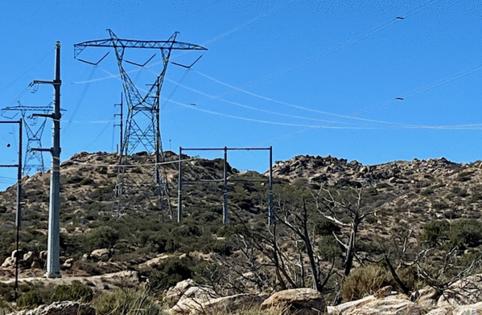California's power grid looks steady heading into summer but risks remain
Published in Business News
California energy officials say the chances of major power outages are relatively low as the state heads into what could be another broiling summer, but they are quick to add that any number of variables could upend the outlook.
“Extreme or sudden onset events could still create tight grid conditions, especially if they are coincidental with a heat wave and (a potential) wildfire knocking out critical generation,” said California Energy Commission vice chair Siva Gunda. “We feel prepared for the summer but remain cautiously optimistic and vigilant.”
Stress on the California’s power system during the summer has been a source of concern in recent years, especially after utility customers across the Golden State experienced rotating power outages mid-August 2020 — and narrowly avoided repeats in 2021 and 2022.
The 2020 outages saw some areas of the state blacked out up to 2 1/2 hours.
California has committed to derive 100% of the state’s electricity from carbon-free sources by 2045, resulting in massive amounts of renewable energy sources (such as solar power) pouring into the grid.
Managers at the California Independent System Operator have to constantly balance the supply of power coming into the system with demand. In the early evening hours, the megawatts produced by solar quickly diminishes as the sun sets. Grid operators must replace that with power from other energy sources in real time to keep the lights on.
The balancing act becomes more difficult in the summertime, when people keep their air conditioners running at the same time that solar production plummets.
Extra power coming online
In a briefing with reporters last week, energy officials said the outlook this summer looks good in large part due to added supplies.
More than 7,000 megawatts of capacity came online in 2024, giving grid managers more cushion.
Since 2021, 20,000 megawatts of new sources have been added. Of that total, battery energy storage accounted for 13,000 megawatts.
“These are resources that will help support reliability needs in California for years to come, not just to meet expected growing demand but also to cover contingencies like extreme weather and unexpected power plant outages,” said Alice Reynolds, president of the California Public Utilities Commission.
Among other contributors:
—The recent decision to extend the operations of Diablo Canyon, the last remaining nuclear power plant in California that generates 2,240 megawatts of electricity, or 9.34% of the entire state’s power mix, and
—The California ISO coordinating with grid managers in other states to bolster reliability through programs such as the Western Energy Imbalance Market that allows partners to automatically find low-cost energy to meet consumer demand in real time across the large geographic area.
During a recent call with reporters, a slide from the California Energy Commission offered a projection for this summer.
The outlook showed 63,765 megawatts of total available resources, more than enough to cover 46,152 megawatts of total demand — although it added a caveat that the figures do not include the risk of wildfires impacting generation or energy imports coming into California from neighboring states.
“The reason wildfires are a risk is because (they) can take out and impact large amounts of supply or transmission that is bringing supply from other parts of the system to California,” said Cal ISO Chief Operating Officer Mark Rothleder.
That’s what happened in July 2021. The Bootleg fire in Oregon tripped a major transmission line called the California-Oregon Intertie that carries imported electricity from the Pacific Northwest into California.
Fire and weather make things worse
The combination of wildfires and extreme weather conditions such as a prolonged heat wave occurring at the same time amount to what energy officials call a “coincidental event,” which sounds a bit bland but can push the grid to the edge.
The rotating outages in 2020 and the close calls in 2021 and 2022 each came when temperatures throughout California soared in late summer. Prolonged hot weather can also hamper the output of natural gas plants, utility substations and other infrastructure carrying electricity if the equipment doesn’t have a chance to cool off in the evening hours.
“It was a very close call in 2021 because of the (Bootleg) fire,” Gunda said. “And then in 2022, we had 10 days of really hot weather across the West. There were multiple days of extreme heat across a large geographic footprint and it put an enormous stress on the grid.”
The long-range weather forecast indicates a decent chance of higher-than-normal temperatures in early part of the summer. A hot start may melt the snowpack in the Sierra Nevada Mountains early and lead to grasses drying out more quickly, which could elevate the risk of fire.
On the other hand, while the forecast shows an increased chance of above-normal temperatures for the interior of California, the risk for higher-than-normal temperatures along the coast appear to be lower this summer.
When the grid is under heavy strain, the California ISO sometimes issues statewide flex alerts — asking utility customers to voluntarily reduce consumption, typically in the late afternoon and early evening hours.
In 2022, a “heat dome” that blanketed California and neighboring states in late August through early September prompted the system operator to issue a record 10 consecutive days of flex alerts. On Sept. 6 of that year, demand in the California ISO system reached its highest mark ever at 52,061 megawatts as utility customers tried to stay cool.
No flex alerts were issued in all of 2023 and 2024.
But the National Oceanic and Atmospheric Administration reported that last year California set a state record for its warmest “meteorological summer” that runs from June through August, based on data going back 130 years.
What happened in Spain?
Last week’s briefing came just four days after power systems in Spain and Portugal suffered a widespread outage that took about 23 hours for the grid to return to normal service.
Officials are still trying to figure out the root cause of the blackout that saw 15,000 megawatts of electricity suddenly vanish within five seconds. About 35,000 stranded passengers had to be rescued from railways and underground tunnels, emergency workers said.
Like California, Spain has made a rapid transition to renewable energy sources. About five minutes before the outage, it was reported that 78% of the country’s grid was running on a combination of solar and wind, leading to debate about whether Spain’s power system has become too reliant on renewable energy sources that can be affected by variables such as weather, rather than conventional sources such as natural gas or nuclear power.
“There was an imbalance of supply,” Jorge Sanz, a former energy official in Spain and board member of the International Energy Agency, told a Spanish TV station, the Financial Times of London reported.
Sanz said an oversupply of electricity may have caused the initial problem and the grid operator could not ask traditional power plants to moderate their outputs because so few plants were online at the time.
Though the root-cause analysis may take weeks, Spanish Prime Minister Pedro Sánchez and the top executive of Spain’s grid denied that renewables made the system more vulnerable.
“Linking what happened … to renewables isn’t correct,” Beatriz Corredor, president of the country’s system operator said. “Renewables work in a stable way.”
When asked if utility customers should worry about something similar happening in the Golden State, Rothleder of the California ISO said there are “many mechanisms to monitor the security of the system and ensure we are operating well within operating parameters to ensure that there is not a large outage or a cascading outage along the lines of what appeared to happen in Spain.”
Rothelder added, “We’ll monitor what comes out of the investigation of the Spain outage and assess if there’s anything new to learn from that.”
The California ISO manages the flow of electricity across high-voltage, long-distance power lines that make up 80% of California’s and a small part of Nevada’s grid.
©2025 The San Diego Union-Tribune. Visit sandiegouniontribune.com. Distributed by Tribune Content Agency, LLC.












Comments